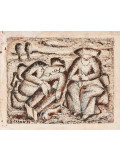
| Period | Modern (1880-1945) |
|---|
Signed.
The name of the painting is on the back, where it is also signed, dated in 1942 and situated in Paris.
| Period | Modern (1880-1945) |
|---|
Signed.
The name of the painting is on the back, where it is also signed, dated in 1942 and situated in Paris.
Ginés Parra (1896 - 1960) was a Spanish painter of the Ecole de Paris.
In 1906 his family emigrated to Algeria where he spent his childhood and adolescence. He then began to draw and model sculptures.
He receives his first artistic training in New York until 1919, at the "Students League".
In 1919, Ginés Parra returned to Zurgena, then left for Paris in 1920. He attends the École des Beaux-Arts, where his teachers are Lucien Simon and Louis Roger.
From 1922 he exhibited at the Salon des Artistes français, the Salon des Indépendants and the Salon d'Automne.
In 1927, he joined forces with the sculptor Julio González and Picasso.
In 1931 he made a trip to Spain, then returned to Paris in 1933 and participated in 1937 in the International Exhibition in the Spanish pavilion.
The Civil War surprised Parra while he was visiting Madrid. He was imprisoned in 1938 for several years in Galicia, then released and returned to Paris. There he meets René Breteau who exhibits him in his gallery in 1942 and 1948. He took part with painters and sculptors of the Spanish school in Paris, notably Picasso, in group exhibitions in Paris, Prague, London, Brussels and Stockholm.
The work :
Halfway between medieval hieratic forms and those of the avant-garde of the first quarter of the 20th century, Parra's work is rooted in the liberations of colour and form brought about by Fauvism and Cubism, combined with austere expressionism. However, it does not belong to any school.
The characteristic of Parra's paintings, whether landscapes, faces or still lifes, is the economy of means. Two or three colours, intense but also soft or bitter, are usually enough, distributed in wide planes and joined to white or grey areas, for the powerfully structured construction of her canvases. On the fringe of any perspective, a thick black graphic design reduces the vision to the essential.
The impasto of their material has made Parra's works comparable to those of Rouault. They are no less similar to the creations of Art Brut.
You must be logged in to post a question or a comment.
Click here to log in
